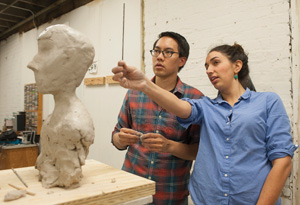Taking advantage of today’s emphasis on active learning, Jennifer Rhodes, M.D, director of VCU’s Center for Craniofacial Care, partnered with a local sculptor, creating a pilot program of art workshops to enhance the plastic surgery residents’ experience.
“We are trying to foster the residents’ imagination, to encourage creativity,” said Rhodes. “Learning about aesthetics of the human body through sculpture is ideal for plastic surgery residents. In sculpting, we can talk about the things we used to talk about in lecture: proportions in face, different features in face, concept of lighting and how it changes your perception of proportion…all things they must understand when they are doing a surgical procedure that affects the aesthetics of the face.
“I think it clicks much better in the residents’ minds when they learn these concepts during a hands-on approach in the artist’s studio rather than on the black board. I have never had the same kind of enthusiasm from them for a lecture.”
“Oh, we do enjoy a good lecture,” said Collier Pace, M’11, a fourth year plastic surgery resident. “But especially for us as surgical types, the hands-on stuff is what we remember and get excited about. Most of us are tactile learners.”
To reach those tactile learners, Rhodes works with VCU sculpture department alumna Morgan Yacoe to design programs that allow residents to learn sculptural techniques and see how they relate to surgery – allowing them to test out aspects of their skill set before they apply them in the operating room.
For example, Yacoe developed a workshop for residents to practice flap design, for which she created replicas of a face with silicone skin and underlying foam.
“They could practice local tissue rearrangement and then suturing to learn about how best to reconstruct different types of skin cancer defects,” said Yacoe. “I tested different silicones to get the elasticity right. They got to practice tool handling, cutting, suturing, rotating the skin and other aspects of flap design and execution before they cut a real patient.”
The lesson was invaluable. “The next time I do this flap, I will have vision in my mind of how I want it,” said Pace. “These are helpful, subtle points that are hard to learn outside the operating room.”
Other workshops have included sculpting clay busts and anatomical drawing. The skills they learn teach residents that healing the body is art as well as science.
“Historically, plastic surgeons had set numbers for things – this is normal range for how thick lips should be or how much eyelid you should see or how far apart the eyes should be,” said Rhodes. “Now, our sensibilities are evolving and in resident education, we stress getting away from the numbers and into developing residents’ own ways of looking at the face, understanding balance and harmony, and understanding what features would be appropriate for a particular individual.”
Mixing up the learning environment by going outside the hospital has another benefit. “Residents can get burned out,” Rhodes said, “and that affects not only their ability to learn, but their empathy towards patients, their outlook on life, their health and their perception of their career path and what they want to do.
“I think transforming a lesson into an experience that they might not have sought on their own and outside their comfort zone is a way to help not only learning but to keep them inspired, foster creative thinking, and enhance their connection to their chosen field.”
By Lisa Crutchfield
